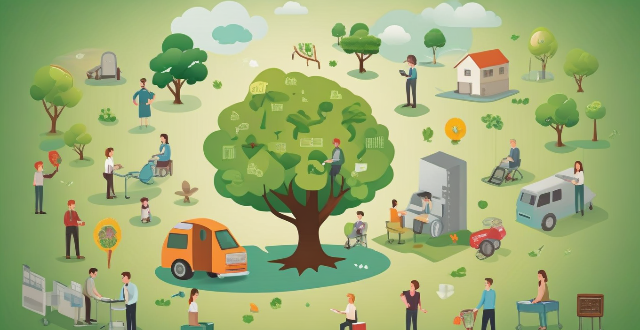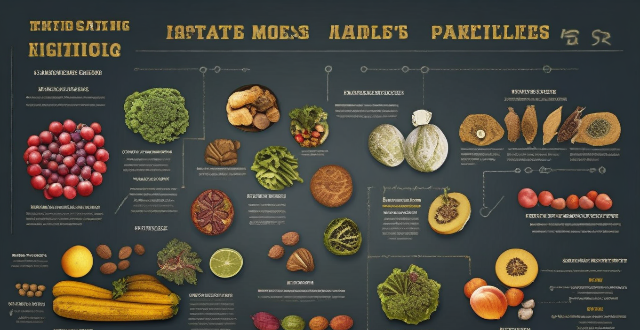Sustainable Farming

How can I support local and organic farming ?
Supporting local and organic farming is crucial for the environment, sustainable agriculture, and community development. To contribute, you can buy local and organic products, volunteer or participate in farming activities, and educate yourself and others about sustainable practices. By making informed choices, you can make a significant impact on supporting local and organic farming.

How does organic farming benefit the environment ?
Organic farming is an agricultural system that emphasizes the use of natural resources and avoids synthetic chemicals such as pesticides, herbicides, and fertilizers. This method of farming has numerous benefits for the environment, including reduced pollution, improved soil health, increased biodiversity, energy conservation, and water conservation. By choosing organic products, consumers can support these environmentally friendly practices and help to create a more sustainable future.

What role do sustainable farming practices play in maintaining food security amidst changing climate conditions ?
Sustainable farming practices are crucial for maintaining food security amidst changing climate conditions. They help farmers adapt to these changes by enhancing soil health, improving water management, promoting crop diversification, and integrating livestock and crop production. These practices also mitigate the impacts of climate change on agriculture by reducing greenhouse gas emissions, promoting biodiversity, and encouraging renewable energy use. Supporting smallholder farmers through training, access to markets, and cooperatives is essential for implementing sustainable practices at a larger scale. Overall, sustainable farming practices are vital for building resilient agricultural systems that can withstand climate change while ensuring food security for future generations.

What is the importance of sustainable agriculture in achieving the Sustainable Development Goals ?
Sustainable agriculture is crucial for achieving the United Nations' Sustainable Development Goals by ensuring food security, improving rural livelihoods, and protecting the environment. It promotes soil health, increases crop yields, encourages biodiversity, creates jobs in rural areas, enhances income, promotes gender equality, reduces greenhouse gas emissions, conserves water resources, prevents land degradation, supports climate change mitigation and adaptation, stimulates economic growth, and reduces poverty. By adopting sustainable agriculture practices, we can create a more equitable and resilient world for future generations.

How do Climate-Smart Technologies contribute to sustainable development ?
Climate-smart technologies play a crucial role in sustainable development by offering solutions that mitigate climate change, adapt to its impacts, and ensure food security while promoting economic growth. These technologies are resource-efficient, low-carbon, and resilient, making them integral components of the sustainable development goals (SDGs). Key ways in which climate-smart technologies contribute to sustainable development include: - Mitigating climate change through renewable energy sources like solar power, wind energy, and hydroelectric power; energy efficiency measures such as building insulation, LED lighting, and smart grids; adapting to climate impacts with water management systems like rainwater harvesting, drought-resistant crops, and flood control infrastructure; agricultural innovations such as precision farming, agroforestry, and cover cropping; enhancing economic growth with green industries like eco-tourism, clean manufacturing, and carbon trading markets; creating jobs and alleviating poverty through sustainable agriculture, renewable energy sector, and climate finance; promoting social well-being through health and safety measures like air quality monitoring, disaster early warning systems, and access to clean cooking solutions; and education and awareness initiatives including climate education programs, community-based adaptation projects, and research and development.

How can we promote sustainable development to reduce the risk of climate conflicts ?
Sustainable development is crucial for reducing the risk of climate conflicts. To promote it, we can increase awareness and education, promote renewable energy sources, implement sustainable agriculture practices, invest in green infrastructure, encourage waste reduction and recycling, and collaborate with governments and NGOs.

How do agricultural practices influence biodiversity ?
Agricultural practices significantly impact biodiversity, affecting ecosystem services like pollination and soil health. Monoculture reduces biodiversity due to habitat loss and pesticide use, while polyculture enhances it through diverse habitats and reduced chemical inputs. Organic farming benefits biodiversity by avoiding synthetic chemicals and promoting natural pest control, whereas conventional farming can harm it through pesticide toxicity and nutrient runoff. Land management practices like tillage disrupt soil ecosystems, while no-till farming preserves them. Water management also plays a role; sustainable practices like drip irrigation conserve water resources and support aquatic life. Adopting sustainable agricultural methods can help conserve biodiversity while maintaining productive systems.

How can we create a sustainable economy that benefits both people and the planet ?
To create a sustainable economy that benefits both people and the planet, several strategies must be employed. These include shifting to renewable energy sources, promoting circular economy practices, encouraging green innovations and technology, implementing sustainable agriculture practices, supporting local economies and fair trade, and raising awareness and education about sustainability. By taking these steps, we can ensure the well-being of current and future generations while minimizing waste, reducing environmental impacts, and conserving natural resources.

How can we promote sustainable development while also tackling climate change and poverty ?
The text discusses a multi-faceted approach to promote sustainable development, tackle climate change and poverty. It suggests strategies such as renewable energy adoption, green economy and job creation, circular economy and resource efficiency, sustainable agriculture and food systems, conservation and protection of natural resources, and inclusive governance and partnerships. By implementing these strategies, we can work towards creating a more equitable and sustainable future for all.

How does climate governance affect sustainable development goals ?
Climate governance plays a pivotal role in shaping the achievement of sustainable development goals (SDGs). The interconnectedness between environmental preservation and socio-economic advancement necessitates a comprehensive understanding of how climate policies and actions influence the broader spectrum of global development objectives. ## **Impact on Individual SDGs** ### *Goal 2: Zero Hunger* Climate governance directly influences food security by addressing factors such as droughts, floods, and temperature fluctuations that can disrupt agricultural productivity. Effective climate policies can help to: - Ensure stable crop yields through improved irrigation systems and drought-resistant crops. - Mitigate the effects of extreme weather conditions on farming communities. - Promote sustainable land use practices to prevent soil degradation. ### *Goal 7: Affordable and Clean Energy* The transition towards renewable energy sources is at the heart of both climate governance and sustainable energy goals. Policies that encourage the adoption of clean energy technologies contribute to: - Reducing greenhouse gas emissions associated with traditional fossil fuel consumption. - Increasing access to electricity in off-grid areas using solar or wind power. - Creating new economic opportunities in the renewable energy sector. ### *Goal 13: Climate Action* This goal is inherently linked to climate governance, as it calls for urgent action to combat climate change and its impacts. Efficient climate policies can lead to: - Implementation of emission reduction strategies. - Enhanced resilience to natural disasters. - Promotion of environmentally friendly industries and jobs. ## **Cross-Cutting Impacts** ### Health and Well-being Climate governance affects public health outcomes by addressing air quality issues and reducing exposure to extreme weather events. This contributes to achieving: - **Goal 3: Good Health and Well-being** by minimizing climate-related health risks. ### Economic Growth Policies that foster green economies and low-carbon development pathways are crucial for: - **Goal 8: Decent Work and Economic Growth** by creating sustainable job opportunities. - **Goal 9: Industry, Innovation, and Infrastructure** through investment in green technology and infrastructure. ### Social Equity Climate governance also has implications for social equity and inclusion, particularly when considering the disproportionate impacts on vulnerable populations: - **Goal 10: Reduced Inequalities** by ensuring that climate adaptation and mitigation efforts do not marginalize already disadvantaged groups. ## **Conclusion** In conclusion, climate governance is an integral component of advancing sustainable development goals. By prioritizing climate action, nations can make strides in eradicating poverty, achieving food security, promoting health and well-being, and fostering economic growth while protecting the planet for future generations. The synergistic relationship between climate governance and the SDGs underscores the necessity for integrated policy approaches that consider environmental sustainability alongside social and economic development.

How can wind energy contribute to a sustainable future ?
Wind energy is a renewable and sustainable source of power that can significantly contribute to a more sustainable future. It offers several benefits including reducing carbon emissions, stimulating economic growth, enhancing energy security, driving technological innovation, compatible land use, community engagement, scalability, improving health impacts, and promoting education and awareness. By incorporating wind energy into our energy mix, we can create a cleaner, healthier, and more sustainable environment for future generations.

How do climate change mitigation efforts interact with sustainable development goals ?
Climate change mitigation efforts and sustainable development goals (SDGs) are closely interconnected, as both aim to achieve a more sustainable future for our planet. In this article, we will explore the relationship between these two important initiatives and how they can work together to create a better world. Climate change mitigation refers to actions taken to reduce or prevent the release of greenhouse gases into the atmosphere. Some examples of climate change mitigation efforts include renewable energy, energy efficiency, forest protection, sustainable agriculture, and waste management. The United Nations has set 17 sustainable development goals (SDGs) to address global challenges such as poverty, inequality, environmental degradation, and climate change. These goals aim to promote economic growth, social inclusion, and environmental protection while ensuring that no one is left behind. Climate change mitigation efforts and SDGs interact in several ways, as they share common goals and strategies. By working together to address these challenges, we can create a more sustainable future for our planet and ensure that no one is left behind.

How does biodiversity loss affect human health ?
Biodiversity loss affects human health in various ways, including increased risk of infectious diseases, decreased mental well-being, and disruption of food systems. To mitigate these effects, individuals can prioritize sustainable consumption habits while governments can implement policies that promote sustainable development and protect natural habitats.

How does sustainable development contribute to the fight against climate change ?
Sustainable development is crucial in the fight against climate change. It aims to balance economic growth, social inclusion, and environmental protection. Mitigating climate change involves transitioning to renewable energy, improving energy efficiency, and developing green infrastructure. Adaptation strategies include sustainable agriculture, water management, and coastal protection. Social equity and environmental justice are also key, with access to clean energy, healthy communities, and climate education being vital. Policy and governance play a significant role through regulatory frameworks, international cooperation, and public participation. Sustainable development provides a framework for integrating climate action into all aspects of society, ensuring a resilient, equitable future for all.

How can I find local experience activities that support sustainable tourism ?
Finding local experience activities that support sustainable tourism is crucial for travelers who want to make a positive impact on the communities they visit. Here's how to do it: 1. **Research Online**: Use sustainable travel portals like Responsible Travel and Green Globe, and check local tourism boards and conservation groups for eco-friendly activities. 2. **Social Media and Forums**: Join travel communities on Facebook and Reddit, and follow influencers and bloggers who focus on sustainable travel for recommendations. 3. **Local Guidebooks and Magazines**: Look for specialized publications like "The Sustainable Travel Handbook" and local magazines featuring eco-friendly activities. 4. **Directly Contact Local Businesses**: Reach out to eco-friendly accommodations like eco-lodges and farm stays, and inquire at local restaurants, especially those focusing on farm-to-table or vegetarian options. 5. **Attend Local Events and Fairs**: Participate in environmental festivals and cultural fairs, and visit farmers markets and artisan markets for insights into sustainable activities. 6. **Use Mobile Applications**: Download apps like EcoCompanion and Book Different to find unique and sustainable accommodations and activities. 7. **Work with Local Guides**: Hire sustainable tour guides and participate in community-based tours that support local economies and conservation efforts. By employing these strategies, you can ensure your travels not only enrich your personal experiences but also contribute positively to the environment and local communities, promoting sustainable tourism practices.

What role does climate-smart technology play in sustainable development goals (SDGs) ?
Climate-smart technology plays a crucial role in achieving the Sustainable Development Goals (SDGs) by mitigating climate change, promoting sustainable agriculture, and supporting economic growth while protecting the environment. It can help reduce poverty by providing access to clean energy, improve agricultural productivity and resilience, improve public health by reducing air pollution, achieve affordable and clean energy, and directly contribute to climate action through the reduction of greenhouse gas emissions and adaptation to the impacts of climate change. Additionally, it can enhance other SDGs indirectly by promoting sustainable practices across various sectors.

Is biomass energy a sustainable solution, considering the resources required to produce it ?
The text discusses biomass energy, which is derived from organic materials like wood, crops, and waste. It is often considered a sustainable alternative to fossil fuels, but its sustainability depends on various factors such as land use, water consumption, nutrient management, and energy inputs. The potential environmental impacts include carbon emissions and waste management. Economic considerations involve job creation and cost competitiveness. Social impact includes energy access and public health. Biomass energy has the potential to be a sustainable solution, but its actual sustainability depends heavily on how it is produced and utilized.

How do organic foods affect taste and nutrition ?
Organic foods have become increasingly popular due to concerns about health, environment, and sustainability. The article discusses the impact of organic farming on the taste and nutrition of food. It suggests that organic foods may have a richer flavor profile due to slower growth rates and no artificial flavorings. However, studies have shown mixed results regarding the nutrient content of organic versus non-organic foods. While some studies suggest higher levels of certain nutrients in organic produce, others find no significant difference. Additionally, organic farming practices aim to reduce pollution, conserve water, and promote biodiversity, contributing to a healthier planet. Ultimately, personal preference, budget, and individual health goals will play a role in deciding whether to opt for organic options.

How can businesses contribute to sustainable consumption ?
Businesses can contribute to sustainable consumption by adopting circular economy principles, managing green supply chains, using eco-friendly packaging, practicing product stewardship, improving energy efficiency, conserving water, engaging in responsible marketing, promoting innovation, engaging stakeholders, and supporting environmental initiatives. These practices help reduce waste, minimize resource use, and inspire sustainable consumer behavior.

What are the main sources of sustainable energy ?
The text discusses the various main sources of sustainable energy, including solar energy, wind energy, hydropower, geothermal energy, bioenergy, tidal and wave energy, and hydrogen energy. It also highlights the importance of adopting sustainable energy for environmental impact, economic benefits, energy security, and health considerations. The transition to sustainable energy requires investment, policy support, and technological innovation.

What are the potential solutions for climate change in agriculture ?
This article explores potential solutions for climate change in agriculture, including sustainable farming practices, water management, crop diversification and rotation, livestock management, energy efficiency and renewable energy, carbon offsetting and sequestration, research and development, and policy interventions. These solutions aim to mitigate the impacts of climate change on crop yields, water availability, and biodiversity, and help build a more resilient and sustainable agricultural sector capable of adapting to changing climate conditions.

How does sustainable consumption impact the economy ?
Reduced resource depletion, lower energy costs, increased innovation, and improved public health are some of the key benefits of sustainable consumption. While there may be short-term costs associated with transitioning to more sustainable practices, the long-term benefits far outweigh these costs.

How can climate financing promote sustainable development ?
Climate financing plays a pivotal role in promoting sustainable development by funding environmentally friendly projects and initiatives. It enhances renewable energy infrastructure, supports sustainable agriculture, fosters green transportation, builds resilience against climate impacts, encourages conservation and biodiversity, promotes environmental legislation and policies, advances research and education, leverages private sector participation, and facilitates international cooperation and technology transfer. By addressing these areas, climate financing serves as a catalyst for sustainable development, helping to align economic growth with environmental stewardship and social equity.

How can sustainable investing help achieve the United Nations Sustainable Development Goals ?
Sustainable investing, which incorporates environmental, social, and governance criteria into investment decision-making, can significantly contribute to achieving the United Nations Sustainable Development Goals. It promotes environmentally friendly practices, enhances social well-being, advances economic growth and innovation, upholds good governance and partnerships, drives market trends towards sustainability, and attracts conscience-driven consumers. By aligning financial objectives with positive societal impact, sustainable investing creates a framework for long-term, sustainable growth that benefits people, planet, and profit.

How do I choose a sustainable investment fund ?
Choosing a sustainable investment fund requires careful consideration of various factors, including your investment goals, the fund's ESG criteria and performance history, the experience of the fund manager, the fund's holdings and alignment with your values, fees and expenses, and ongoing monitoring of your investment. By following these steps, you can select a sustainable fund that aligns with your financial goals and personal values.

Is it ethical to engage in deforestation for agricultural purposes ?
Is it ethical to engage in deforestation for agricultural purposes? This question requires a nuanced understanding of both environmental ethics and the needs of agriculture. The case against deforestation includes loss of biodiversity, climate change, and soil erosion and water quality issues. However, the case for agricultural deforestation includes food production, economic opportunities, and sustainable practices. To navigate the ethical implications of deforestation for agriculture, a balanced approach is crucial, including reducing new land needed, regenerative agriculture, agroforestry, policy and regulation, and public awareness. While the need for agricultural land is pressing, engaging in deforestation without considering its broader ecological consequences is not ethically sustainable. It is essential to find ways to meet our agricultural needs while also preserving the integrity of our planet's ecosystems. By promoting sustainable agriculture and implementing protective measures, we can move towards a future where food production and forest preservation coexist harmoniously.

What are the risks of sustainable investing ?
Sustainable investing carries risks such as inconsistent screening criteria, limited investment opportunities, higher costs, regulatory and legal issues, market risks, and reputational risks. Investors should carefully consider these risks before making investment decisions to ensure that sustainable investing aligns with their goals and risk tolerance.

What impact have celebrities had on promoting sustainable fashion ?
### Summary: Celebrities significantly influence sustainable fashion promotion by raising awareness, shaping trends, supporting eco-friendly brands, driving industry changes, and setting personal examples of sustainability. Through campaigns, social media engagements, and public appearances in sustainable fashion, they encourage followers to adopt more environmentally conscious choices. Their actions not only increase the visibility of sustainable brands but also push for greater transparency and ethical practices within the fashion industry.

What are the benefits of using sustainable energy sources ?
Using sustainable energy sources provides environmental, economic, and social benefits. These include reduced greenhouse gas emissions, improved air quality, conservation of natural resources, protection of ecosystems, cost savings, job creation, energy independence, stable energy prices, improved public health, community resilience, education and innovation, and increased energy access. Transitioning to sustainable energy is essential for our future prosperity and survival.

How can we ensure that the benefits of sustainable development reach everyone, including the most vulnerable groups ?
The text discusses how sustainable development can be ensured to reach everyone, including the most vulnerable groups. It suggests a multifaceted approach that involves balancing economic growth, social inclusion, and environmental protection. The strategies include developing inclusive policies, ensuring access to opportunities like education and training, investing in sustainable infrastructure and accessible services, encouraging community engagement and advocacy, and implementing monitoring and accountability measures. By working together across sectors and levels of society, a more equitable and sustainable future can be built for all.